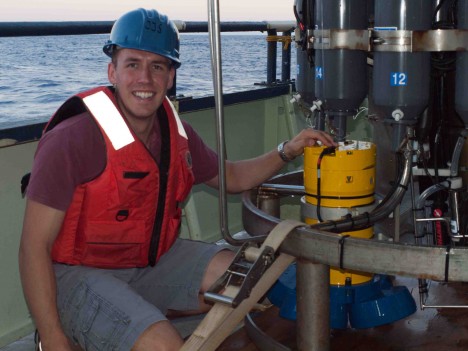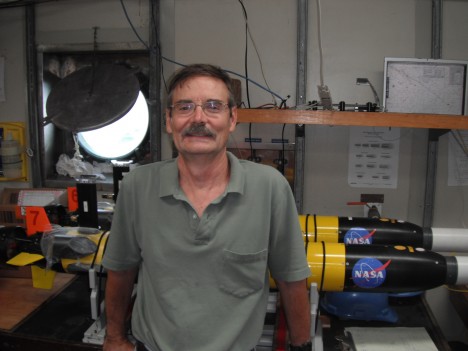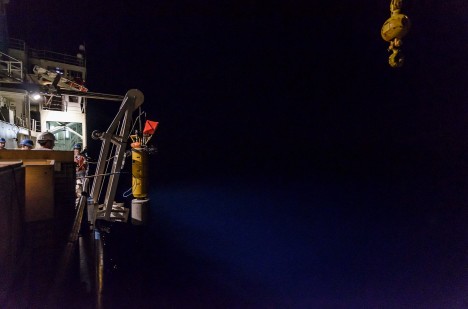By Eric Lindstrom
The SPURS work has renewed interest in the broader community in studying the ocean to better understand the global water cycle, heating and cooling of the oceans, and oceanic mixing.
Julian Schanze of Woods Hole Oceanographic Institution/MIT is about to complete his Ph.D. in physical oceanography under the supervision of Ray Schmitt. Julian and Ray are on the Knorr to study ocean salinity, the water cycle and mixing in the ocean.
For his Ph.D. project, Julian is trying to estimate how much mixing occurs in the ocean. For this, he is using satellite datasets on surface fluxes of heat and fresh water and a concept known as power integrals. This is a mathematically complex subject, so let’s avoid the technical details and consider it in simpler terms.
Consider that, broadly speaking, the Earth is heated near the equator and cooled near the poles. For the equatorial and polar regions to not heat up or cool down, respectively, the excess heat must be transported away from the equator and towards the poles through mixing. The same approach can be used for the water cycle (which creates salt differences) as well such as ocean density and other, let us say “weird” ocean variables. For example, oceanographers consider the “spiciness” of ocean water as a measure of how warm and salty it is. So Julian is doing something really cool and looking at not just at heat moving through the ocean, but density and spiciness fluctuations as well. These are directly related to vertical and horizontal mixing in the ocean.
The equations that govern these power integrals relate the production of heat and salt variance (in our example, heating at the equator and cooling at the poles) to the destruction of variance (mixing) in the interior ocean. However, Ray and Julian found something curious: Under the right circumstances, the ocean interior can produce density variance rather than destroy it. The reason for this is double diffusion or salt fingers. When warm, salty water is found atop cool, fresh water, heat is diffused faster than salt in the ocean, leading to the formation of cold and salty “salt fingers”. These salt fingers transport salt downward and can create sharp density gradients. The SPURS region is top heavy in salt and therefore a likely place to find salt fingers.
On this SPURS cruise, Julian is trying to extend his understanding of mixing in the oceans from theoretical studies to hands-on work with the data. He is hoping the data will help him constrain uncertainties in the global maps of the water cycle and the heat budget that he has assembled. But while the approach he has taken in his dissertation allows him to calculate the total sum of mixing in the ocean, it does not constrain where the mixing occurs. This is where instruments deployed in SPURS enter the picture. Some of the SPURS instruments specifically allow for mixing in the ocean interior to be estimated by recording miniscule changes in temperature, salinity, and velocities in the ocean. The Vertical Microstructure Profiler and several of the gliders equipped with similar technologies allow oceanographers to estimate mixing quite precisely.
On board, Julian is in charge of the Lowered Acoustic Doppler Profiler (LADCP), an instrument lowered on a wire that records horizontal velocities in the ocean by pinging sound waves off small particles that float in the water. This requires him to prepare the instrument for deployment, charge its batteries and process the data after the retrieval. The LADCP helps identify good sites for mixing by measuring where the velocity changes most rapidly with depth.
How did Julian get to be such an intelligent man? He tells me that at age seven, he moved close to the North Sea in Germany and became fascinated by the ocean. He soon became a keen sailor and decided to complete a four-year B.S./M.Sci. degree in oceanography at the University of Southampton in England. While his research has been largely focused on using satellite data to estimate the global water cycle (80-90 percent of which occurs over the ocean), he is thrilled at being able to go on a month-long research cruise to get in touch with the subjects he has been studying for the last 9 years. His fascination with satellite remote sensing and his research in oceanography are perfectly combined in NASA’s work on SPURS and the advent the Aquarius satellite, to measure sea surface salinity from space.
Everyone on Knorr believes that Julian has a stellar career in front of him!
Tags: NASA, ocean mixing, oceanography, salinity, SPURS, SPURS1







